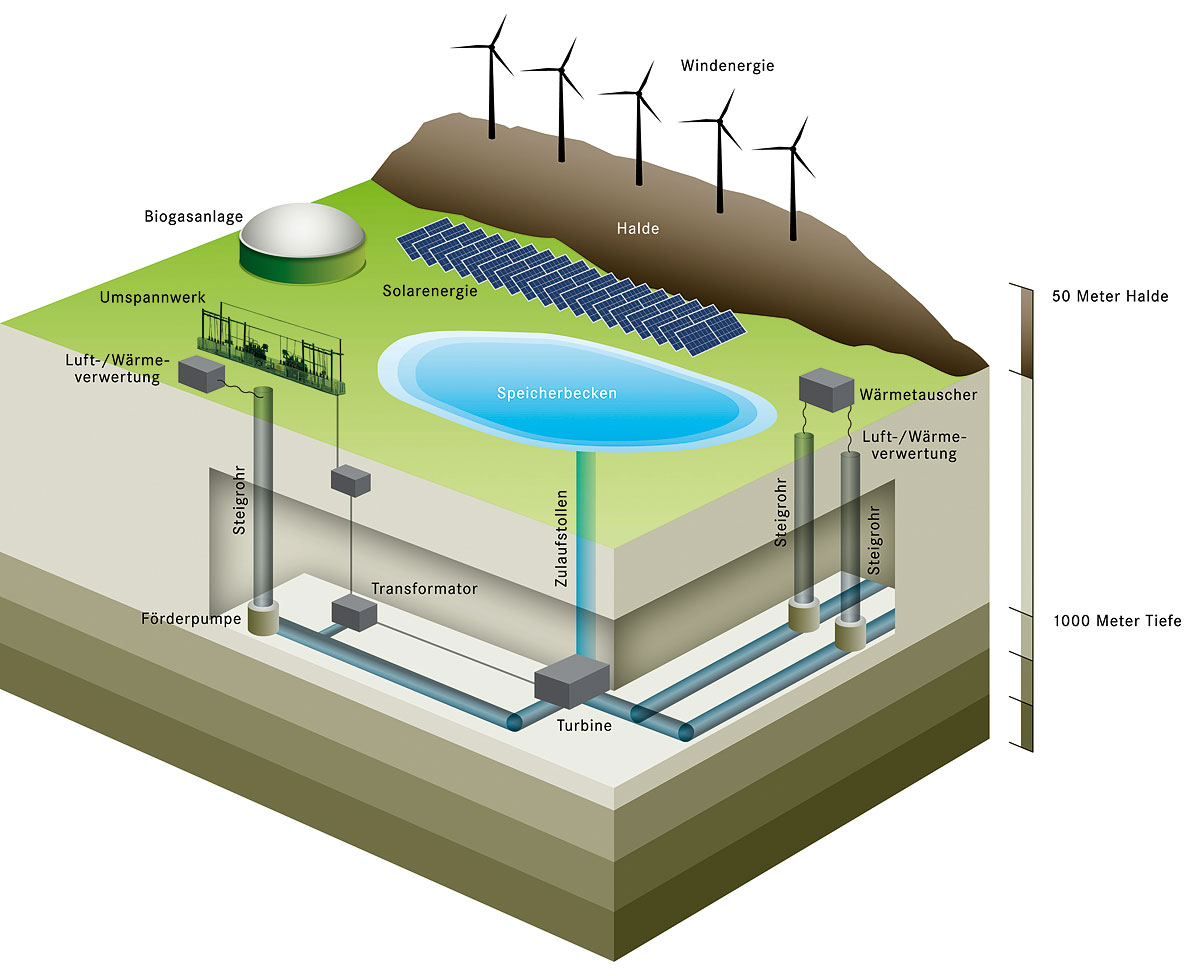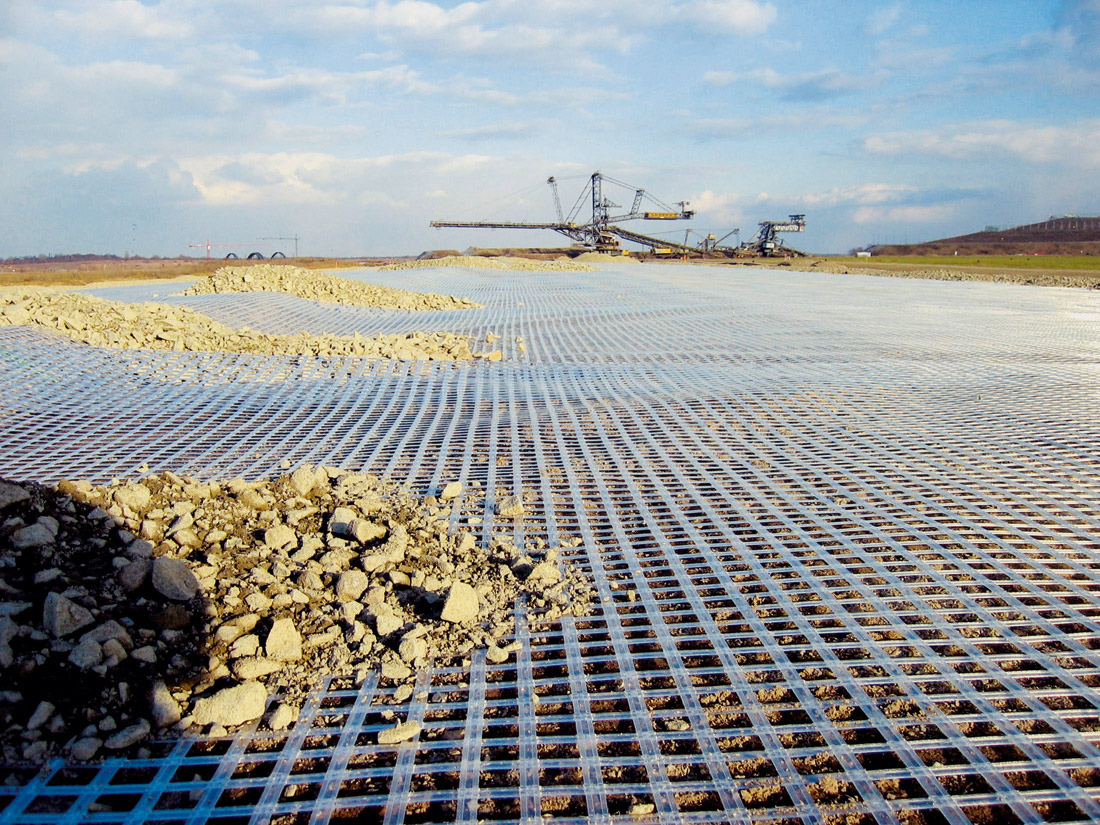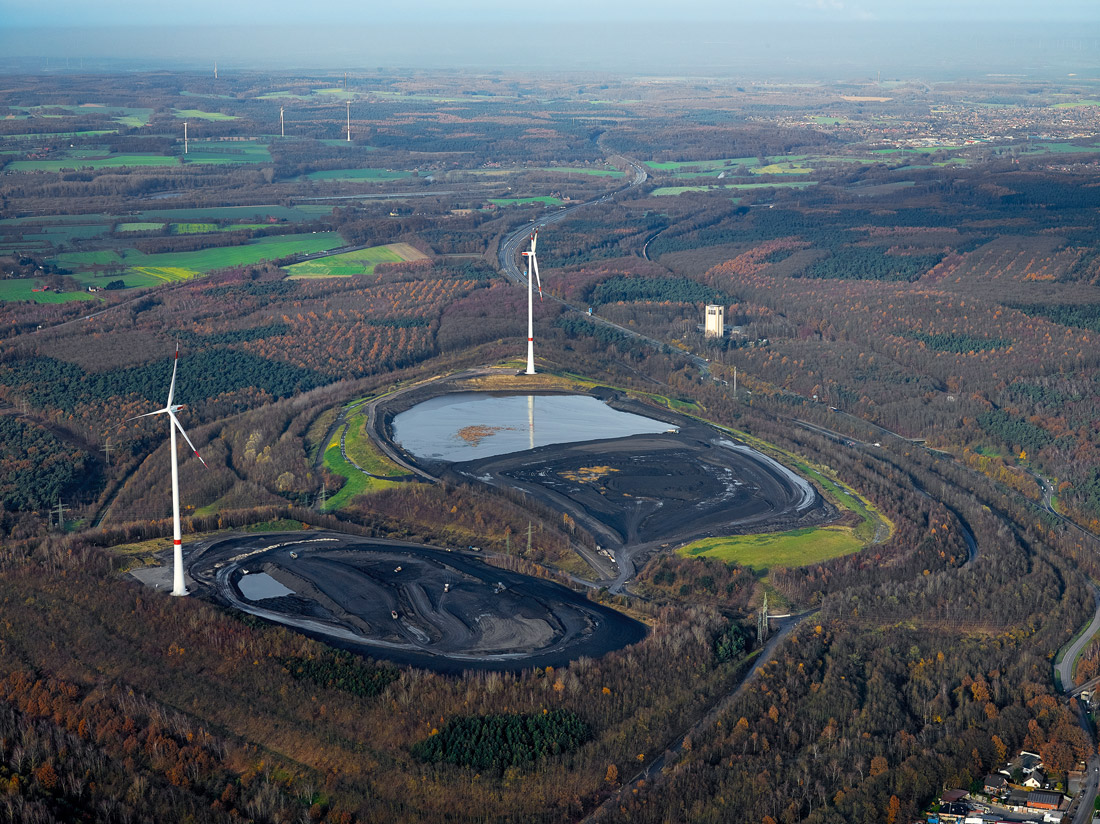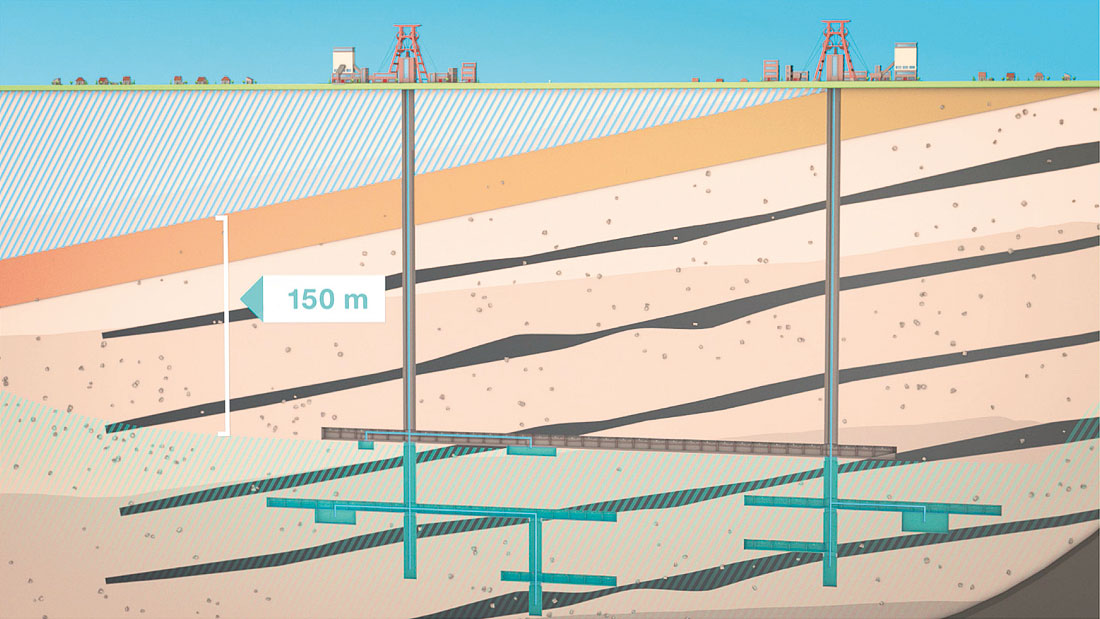It has now been a year since Mining Report Glückauf took on the theme post-mining. The main focus at the time was on issues connected with company organisation and structure in the transition from active mining to the post-mining era and – using as an example the safekeeping measures applied in the former Thuringian potash mining industry – how it is possible to deal with historical legacies such as open mine workings and spoil tips. I would like to pick up this thread once more, though this time from a different perspective. For the infrastructure that has been left behind by the mining industry needs to be safeguarded and secured so effectively that there is no likelihood of damage to persons or to the environment. Indeed productive new uses can even be found for sites of this kind.
Read moreWith my best regards // Mit freundlichem Glückauf
Dipl.-Ing. Andreas-Peter Sitte
Chief Editor Mining Report Glückauf, Essen
Green Energy Generating a new Impetus

Fig. 1. Three wind energy plants on the Brinkfortsheide spoil tip in Marl are generating eco-friendly energy. All three wind turbines were built by Windkraft Brinkfortsheide GmbH, a subsidiary of the RAG Foundation and the RAG company. // Bild 1. Auf der Halde Brinkfortsheide in Marl liefern drei Windenergieanlagen umweltfreundlichen Strom. Bauherr ist die Windkraft Brinkfortsheide GmbH, eine Tochtergesellschaft der RAG-Stiftung und der RAG. Photo/Foto: RAG Montan Immobilien/Thomas Stachelhaus
The property developers RAG Montan Immobilien GmbH, Essen/Germany, are now planning a series of forward-looking change-of-use projects on some 9,020 ha of company-owned land and properties that were previously part of the RAG corporate portfolio. Proposals for potential new developments also involve schemes based on the use and generation of renewable energies, including the use of solar power, spoil-tip wind and biomass to produce heat energy and electricity. The projects are to be implemented in association with outside partners and investors, starting with local authorities and municipal utilities through to energy supply companies.
All these initiatives have one central aim, namely to safeguard the scientific and technical know-how of the mining industry as a basis for future-proof products and to …
Author: Frank Schwarz, stellvertretender Pressesprecher, RAG Montan Immobilien GmbH, Essen
Read moreClimate-Friendly Heating with Heat Utilisation from Mine Water in Post-Mining
With 5.5 million inhabitants, the Ruhr Area is one of the largest urban centers in Europe. In times of the industrialization, the Ruhr Area became an industrial conurbation. The coal mines which are now part of the RAG Aktiengesellschaft, Essen/Germany, provided work.
Due to the underground coal mining in depths of more than 1,000 m, there is an area with several mines and chambers in the underground of the Ruhr Area. Rainwater seeps into the resulting cavities. On the way through the rocks, minerals dissolve in the water. The rainwater becomes mine water. In the past, pumping the accumulated mine water was necessary to protect the active underground tunnels and shafts. In 2018, all coal mines in and around the Ruhr Area will be closed. Nowadays, the most important goal is to ensure that no rising mine water reaches the groundwater level. Therefore, continuous pumping of the mine water is required even after active coal mining.
The aim of the project Grubenwasser-Ruhr (GW-Ruhr) is using the thermal energy in mine water to supply geothermal heating energy. The mine water has …
Authors: Tobias Reiners M. Sc., Prof. Dr.-Ing. Hermann-Josef Wagner, Dr.-Ing. Nils Penczek, Lisa Altieri M. Sc., Michael Gross M. Sc., Lehrstuhl Energiesysteme und Energiewirtschaft (LEE), Ruhr-Universität Bochum (RUB), Bochum
Read moreUtilisation of Underground Mining Infrastructure as Pumped Storage Power Plant
Pumped-storage power plants are an efficient option for energy storage to address short-term variances. In general, pumped-storages are dependent on high differences in altitude and therefore located in mountainous areas. An advantageous variation is the installation of pumped-storage power plants completely or partially underground. Three variations are feasible: usage of the infrastructure of closed mines, usage of the infrastructure of operating mines, and usage of unexploited rock. Feasibility studies for the installation of pumped-storages in closed and operating mines have been presented and discussed. Pumped-storage power plants are crucial for the restructuring of Germany´s energy system but until they can be economically implemented it is up to the politicians to encourage the realisation of such projects.Author: Prof. Dr.-Ing. Oliver Langefeld, Institut für Bergbau der Technischen Universität (TU) Clausthal, Clausthal-Zellerfeld
Read moreProposed Underground Pumped Hydro Storage Power Plant at Prosper-Haniel Colliery in Bottrop – State of Play and Prospects

Fig. 1. Schematic diagram of an underground pumped hydro storage power plant with additional energy-generating systems based around disused mining infrastructure. // Bild 1. Prinzipskizze eines untertägigen Pumpspeicherwerks und weitere Komponenten der energetischen Folgenutzung bergbaulicher Infrastruktur. Source/Quelle: Universität Duisburg/Essen
Authors: Prof. Dr.-Ing. André Niemann und Jan Peter Balmes M. Eng., Institut für Wasserbau und Wasserwirtschaft, Prof. Dr. rer. nat. Ulrich Schreiber, Fachgebiet Geologie, Universität Duisburg-Essen, Essen, Prof. Dr.-Ing. Hermann-Josef Wagner, Lehrstuhl Energiesysteme und Energiewirtschaft (LEE), Ruhr-Universität Bochum, Bochum, Dipl.-Ing. Tobias Friedrich, DMT GmbH & Co. KG, Essen
Read moreNew Technologies, new Deposits, new Prospects? Economic and Legal Reflections on Raw Materials
A (post-)mining Germany produces approximately 750 mt of resources per year. The top position is held by the German rock industry with its annual production of approximately 500 mt aggregate (gravel, sand, and stones). It might be difficult to imagine that the rapid development of open data, digitalisation, modern communication systems, driverless cars, smart technology and the Internet of Things might be suffering from a lack of resources in the foreseeable future. But exactly that is the central issue to explore: how secure is our supply and the physical availability of resources?
This essay will be looking at current informations and aspects to develop prospects from those. It will be picking up the deposit potential of former mine workings and landfills and link them with the expertise of the mineral resource industry. Moreover, it will deliver an initial assessment …
Authors: Prof. Dr.-Ing. Peter Goerke-Mallet, Forschungszentrum Nachbergbau, Abteilungsdirektor a. D. Michael Kirchner, Lehrbeauftragter, Prof. Dr.-Ing. Albert Daniels, Rohstoffgewinnung über und unter Tage, Technische Hochschule Georg Agricola (THGA), Bochum
Read moreThe Use of Geosynthetics in Mining Works

Fig. 5. Application of geogrids in mining operations. // Bild 5. Anwendung von Geogittern im Bergbau.
Authors: Dipl.-Geol. Dipl.-Wirtsch.-Ing. Andy Post, Gebietsleiter Subsahara-Afrika, Dipl.-Ing. Kent v. Maubeuge, Marketingdirektor und Produktmanagement, NAUE GmbH & Co. KG, Espelkamp
Read moreThe Post-Mining Era – a new Research Programme also for Economics

Fig. 1. Wind turbines on the Brinkfortsheide spoil tip. // Bild 1. Windenergieanlagen auf der Halde Brinkfortsheide. Photo/Foto: RAG
Author: Dr. rer. oec. Kai van de Loo, Gesamtverband Steinkohle e. V. (GVSt), Essen, und Lehrbeauftragter für Volkswirtschaftslehre, Technische Hochschule Georg Agricola (THGA), Bochum
Read moreWill Nature Conservation Spell the End of Opencast Mining at Hambach?
Nature protection has now moved onto the agenda for Hambach lignite mine. Environmentalists have set up a camp on the site and the Berlin-based German Federation for Environment and Nature Conservation (BUND) has petitioned for legal protection as an environmental organisation. Can habitat and species protection as part of EU legislation stop lignite mining in its tracks?
Author: Prof. Dr. jur. Walter Frenz, Lehr- und Forschungsgebiet Berg-, Umwelt- und Europarecht, Rheinisch-Westfälische Technische Hochschule (RWTH) Aachen, Aachen
Read more


















